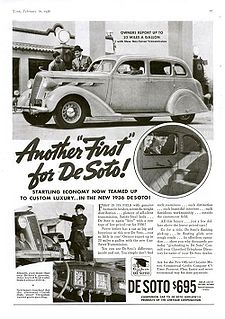
DeSoto Airstream
Encyclopedia

Automobile
An automobile, autocar, motor car or car is a wheeled motor vehicle used for transporting passengers, which also carries its own engine or motor...
built by the Chrysler Corporation and sold through its DeSoto
DeSoto (automobile)
The DeSoto was a brand of automobile based in the United States, manufactured and marketed by the Chrysler Corporation from 1928 to 1961. The DeSoto logo featured a stylized image of Hernando de Soto...
division during model years 1935 and 1936. During both years, the car was sold along with the streamlined
Streamliner
A streamliner is a vehicle incorporating streamlining in a shape providing reduced air resistance. The term is applied to high-speed railway trainsets of the 1930s to 1950s, and to their successor "bullet trains". Less commonly, the term is applied to fully faired recumbent bicycles...
DeSoto Airflow
DeSoto Airflow
The DeSoto Airflow was an automobile built by the Chrysler Corporation for sale through its DeSoto division during model years 1934, 1935 and 1936. DeSoto received the then-revolutionary Airflow model due to its price structure relationship to larger and more expensive Chrysler brand cars. The 1934...
. The DeSoto Airstream 4-door sedan sold for $220 less than a 4-door DeSoto Airflow. Chrysler fielded its own Chrysler Airstream
Chrysler Airstream
The Chrysler Airstream was an automobile produced by the Chrysler division of the Chrysler Corporation in 1935-1936. The Airstream was a conventional looking automobile that was trimmed to evoke a feeling of streamlined design...
model concurrently; visual cues separated the two automobiles.
More successful than Airflow
The Airstream was created to capture market share lost during the 1934 season when DeSoto only offered the Airflow. 20,784 Airstream cars sold in 1935, as compared to 6,797 Airflow models. Airstream sales nearly doubled the units of Airflows, 13,940, sold in 1934. While streamlined and aerodynamic, the Airflow was not embraced by the public, and the more mainstream Airstream was introduced as a stop-gap measure until a fully redesigned DeSoto could be introduced in 1937.In reviewing the Airstream, conventionality was its best attribute. Solidly built, and more conservatively styled, the 241.5CID 6-cylinder Airstream did away with the Airflow's integrated headlights, broad grille work and monocoque
Monocoque
Monocoque is a construction technique that supports structural load by using an object's external skin, as opposed to using an internal frame or truss that is then covered with a non-load-bearing skin or coachwork...
construction. While the super structure of the Airstream was all-steel (as opposed to wooden framing - a practice still followed by some US automakers in the mid-1930s), the car rested on its frame, while Airflow's unibody build qualities placed the passenger compartment within the frame structure. It has a 118" wheelbase.
Design, options, and pricing
Body styles for 1935 included 2-door business coupe, convertible coupe, roadster coupe, 5-passenger coupe and trunkback sedan. Four-door offerings included a base sedan and a trunkback sedan. The cars featured Chrysler’s vaunted “Floating Power” rubber engine mounts which isolated engine vibration from the chassis. Optional features included carpeting for the front seat area, radio, twin windshield wipers and a heater.Airstreams were priced about $200 dollars less than the DeSoto Airflow. That, plus the more traditional styling, made the car a success.
1936 features and sales
In 1936 the Airstream was split into two trim levels, Deluxe and Custom. Deluxe models had one piece windshields while Customs (exp. the convertible) had two piece units which were quickly becoming the industry standard. The senior series also gained a Custom Traveller model, built on a stretched 130" wheelbase. Custom travellers were popular with limousine conversion companies and marked the beginning of DeSoto's long standing, and profitable relationship with the TaxicabTaxicab
A taxicab, also taxi or cab, is a type of vehicle for hire with a driver, used by a single passenger or small group of passengers, often for a non-shared ride. A taxicab conveys passengers between locations of their choice...
industry.
For 1936 total sales improved to 38,938 units, of which the Airstream accounted for 33,938 units compared to the reduced Airflow offerings with returned 5,000 units for the Airflow's final year.

